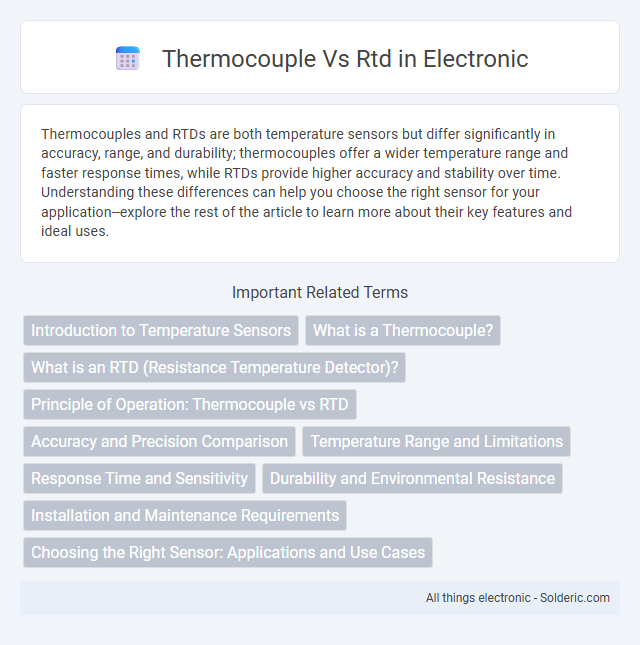Thermocouples and RTDs are both temperature sensors but differ significantly in accuracy, range, and durability; thermocouples offer a wider temperature range and faster response times, while RTDs provide higher accuracy and stability over time. Understanding these differences can help you choose the right sensor for your application--explore the rest of the article to learn more about their key features and ideal uses.
Comparison Table
| Feature | Thermocouple | RTD (Resistance Temperature Detector) |
|---|---|---|
| Measurement Range | -200degC to 1750degC | -200degC to 850degC |
| Accuracy | +-1degC to +-2degC | +-0.1degC to +-0.5degC |
| Response Time | Fast (milliseconds to seconds) | Moderate (seconds) |
| Durability | High, resistant to shock and vibration | Moderate, sensitive to mechanical shock |
| Output Signal | Millivolt (mV) thermoelectric voltage | Resistance change (ohms) |
| Cost | Lower cost | Higher cost |
| Installation Complexity | Simple, needs reference junction compensation | Requires precise wiring and current source |
| Common Applications | Industrial furnaces, gas turbines, kilns | Laboratory, process control, HVAC |
Introduction to Temperature Sensors
Thermocouples and RTDs are widely used temperature sensors in industrial and scientific applications, each with distinct operating principles and performance characteristics. Thermocouples generate a voltage based on the Seebeck effect involving two dissimilar metals, suitable for high-temperature measurements and rapid response times. RTDs, or Resistance Temperature Detectors, measure temperature through changes in electrical resistance of pure metals like platinum, offering superior accuracy and stability ideal for precise temperature control in your processes.
What is a Thermocouple?
A thermocouple is a temperature sensor consisting of two dissimilar metal wires joined at one end, producing a voltage proportional to temperature differences between the junction and the reference point. It offers a wide temperature range measurement, fast response time, and durability in harsh environments, making it ideal for industrial applications. Understanding the thermocouple's function helps you select the right sensor based on temperature range, accuracy, and application needs.
What is an RTD (Resistance Temperature Detector)?
An RTD (Resistance Temperature Detector) measures temperature by correlating the resistance of a metal, typically platinum, to temperature changes, offering high accuracy and stability. Unlike thermocouples, which use voltage generated at junctions of different metals, RTDs provide precise and repeatable temperature readings ideal for laboratory and industrial applications. Your choice between an RTD and a thermocouple depends on the required measurement accuracy, temperature range, and environment.
Principle of Operation: Thermocouple vs RTD
Thermocouples operate on the Seebeck effect, generating a voltage proportional to the temperature difference between two dissimilar metal junctions, allowing measurement of a wide temperature range with fast response times. RTDs (Resistance Temperature Detectors) function based on the predictable change in electrical resistance of pure metals, such as platinum, as temperature varies, providing highly accurate and stable readings over a limited temperature span. Choosing between a thermocouple and RTD depends on your need for temperature range, accuracy, and response speed in your specific application.
Accuracy and Precision Comparison
RTDs (Resistance Temperature Detectors) provide higher accuracy and precision compared to thermocouples, with typical accuracy ranges of +-0.1degC to +-0.5degC versus thermocouples' +-1degC to +-2degC. RTDs maintain stability over time and offer consistent measurements in controlled temperature environments, making them ideal for applications requiring precise temperature monitoring. When your process demands reliable accuracy and minimal drift, RTDs outperform thermocouples, despite thermocouples offering a wider temperature measurement range.
Temperature Range and Limitations
Thermocouples typically operate across a broad temperature range from -270degC to 2300degC, making them ideal for high-temperature applications such as furnaces and jet engines. RTDs (Resistance Temperature Detectors), usually made of platinum, function accurately within a narrower range of -200degC to 850degC, offering higher precision but limited maximum temperature capacity. The limitations of thermocouples include lower accuracy and susceptibility to drift over time, whereas RTDs are constrained by their physical durability and cost at extreme temperatures.
Response Time and Sensitivity
Thermocouples respond to temperature changes rapidly, often within milliseconds, making them ideal for dynamic environments requiring quick measurements. RTDs (Resistance Temperature Detectors) offer higher sensitivity and accuracy due to their stable resistance-temperature relationship but have a slower response time, typically ranging from seconds to minutes. Your choice depends on whether fast response or precise sensitivity takes precedence in your temperature measurement application.
Durability and Environmental Resistance
Thermocouples exhibit exceptional durability and can withstand extreme temperatures, making them suitable for harsh industrial environments with rapid temperature changes or vibration. RTDs offer superior accuracy and stability but are more sensitive to mechanical stress and contamination, requiring careful handling in corrosive or high-vibration settings. Choosing between these sensors depends on your application's environmental demands and the level of durability required for reliable temperature measurement.
Installation and Maintenance Requirements
Thermocouples require simpler installation due to their small size and two-wire connection, while RTDs demand more careful wiring and often use three or four wires to ensure accuracy. Maintenance for thermocouples involves periodic replacement as they degrade over time, whereas RTDs primarily need calibration maintenance to preserve precision. Your choice impacts long-term upkeep, with RTDs generally requiring more precise handling but offering better durability in stable conditions.
Choosing the Right Sensor: Applications and Use Cases
Thermocouples are ideal for high-temperature applications and rapid temperature changes, commonly used in industries like metal processing and gas turbines. RTDs provide precise and stable temperature measurements over a moderate range, making them suitable for laboratory settings and HVAC systems. Your choice depends on the required accuracy, temperature range, and environmental conditions of your specific application.
thermocouple vs rtd Infographic

 solderic.com
solderic.com